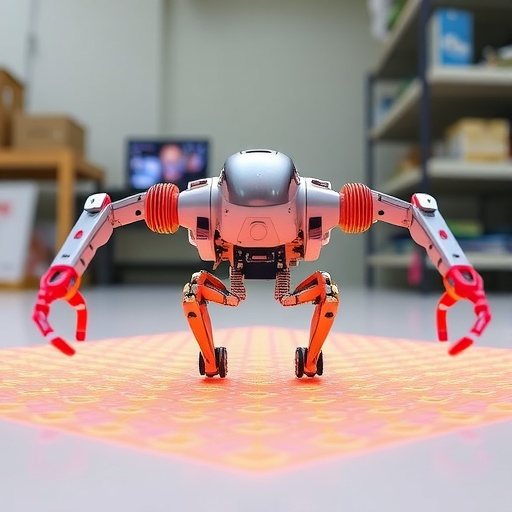
The world of robotics continuously experiences a transformative journey as researchers innovate materials and methods to enhance robotic performance. A groundbreaking study from Pusan National University in South Korea introduces a novel approach to the fabrication of fiber-reinforced polymers (FRPs) that has significant implications in the realm of soft robotics and deployable technology. As the need for versatile and reliable robotic systems grows, this study could potentially set new industry standards.
In recent years, the intersection of robotics and material science has garnered significant attention. Among the various developments, the utilization of origami-inspired structures has emerged as a hallmark of innovation. These structures, characterized by their ability to fold and unfold swiftly while maintaining operational integrity, are ideal for applications in aerospace, architecture, and healthcare. Unlike traditional materials like paper and thin glass, FRPs present a more robust alternative that integrates both rigidity and flexibility into a singular format.
The research team, under the direction of Associate Professor Dong Gi Seong, has embarked on a mission to address the current limitations in FRP fabrication. The proposed multi-resin dispensing process selectively incorporates rigid and flexible epoxy resins at predetermined locations within a single monolithic setup. This intricate design allows the mechanical properties to be finely tuned, enabling a dual functionality that empowers robotics with enhanced flexibility coupled with sufficient strength.
The significance of this innovation cannot be overstated. Traditionally, robotic components have been manufactured using a singular resin, which inherently limits the functional application of these parts. The dual-resin approach introduced through this study enables a revolution in how robotic limbs and components are designed. Not only does this result in lighter systems, but it also mitigates the trade-offs that engineers often face when integrating different material properties for varying functions.
As Dr. Seong elaborates, this method offers a notable enhancement in the composite’s performance characteristics. The resulting structures possess impressive metrics, such as a flexural modulus of 6.95 GPa in rigid segments and a mere 0.66 GPa in foldable areas. This stark difference underscores the potential applications in environments that require reliability without compromising on the ability to manipulate and adapt to circumstances. The triangulated cylindrical origami structure fabricated by the team stands as a testament to their ingenuity, showcasing the practical benefits of integrating advanced composite materials within robotic frameworks.
More than just a novel technique, the implications of this research broaden the horizons for innovation across numerous fields. By utilizing composite materials that can adjust their rigidity and flexibility dynamically, robotic engineering moves a step closer to realizing transformational concepts, including humanoid robots and multi-functional robotic arms. This adaptability paves the way for robots that can transition from rigid motions to soft, nuanced movements, reflecting natural biological systems.
In addition to robotics, the applications extend into various futuristic technologies. This includes the potential for deploying solar panels in space, enabling structures that can compactly store and efficiently unfold to harness solar energy. Furthermore, the ability to create foldable electronics might usher in advancements in consumer technology, leading to more compact, portable devices that retain high functional capabilities.
The potential applications of this new FRP technology are not limited to terrestrial uses. Dr. Seong suggests it could also find significant roles in military and emergency response scenarios, particularly with durable, foldable shelters that are easy to transport and deploy in disaster situations. The advancements made here could directly impact the efficiency and effectiveness of response strategies when unexpected events occur, saving lives and resources alike.
Moreover, the fascinating capabilities of this technology could entail a step toward next-generation vehicles. Imagine a transport system equipped with wheels that can adapt in real-time to various terrains and conditions, enhancing mobility and reducing energy consumption. The promise of achieving such adaptability in vehicle design creates a ripple effect, influencing industries striving for innovation and efficiency.
As robotics and associated technologies continue to evolve, the groundwork laid by this research could lead to significant advancements in how robots are designed, constructed, and utilized. The fusion of soft and rigid components represents a paradigm shift in understanding what is possible in robotic engineering.
Another aspect worth mentioning is the commercialization of this technology. Industries are likely to observe an influx of interest from manufacturers and developers eager to integrate tailored FRPs into their existing designs or create entirely new applications. The ingenuity showcased in this research highlights a clear pathway toward achieving unprecedented functionality and performance in commercial robotics.
The journey of this research is far from over. As follow-up studies and practical applications emerge, the scientific community will likely seek to refine and innovate even further, making robotic solutions increasingly sophisticated. The collaborative efforts at Pusan National University set an example for interdisciplinary teams working at the cutting edge of science, emphasizing the critical role that material innovations play in the advancement of technology.
As we stand on the brink of this new era in robotics, the work of Professor Dong Gi Seong and his team shines as an emblem of potential breakthroughs that await us. Their commitment to exploration and innovation is a reminder that the fusion of research, technology, and creativity will continue to shape the future of robotics and beyond.
Subject of Research:
Fiber-Reinforced Polymer for Advanced Monolithic Rigid–Soft Robotics Applications
Article Title:
Deployable Fiber-Reinforced Polymer for Advanced Monolithic Rigid–Soft Robotics Applications
News Publication Date:
1-Oct-2025
Web References:
https://www.sciencedirect.com/science/article/pii/S1359836825006602
References:
[1] DOI: 10.1016/j.compositesb.2025.112754
Image Credits:
Dong Gi Seong from Pusan National University
Keywords
Robotics, Engineering, Artificial Intelligence, Electronics, Polymer Engineering, Composite Materials
Tags: composite materials for roboticsdeployable technology in roboticsfiber-reinforced polymers innovationfuture of robotics technologymaterial science in roboticsmulti-resin dispensing processorigami-inspired structures in engineeringPusan National University researchrobotic performance enhancementself-deploying materialssoft robotics advancementsversatile robotic systems development




